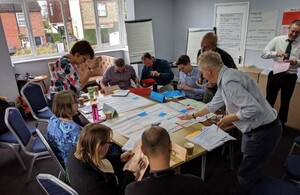Working together to adapt to a changing climate
Research supported authorities to work with communities when planning to reduce flood and coastal erosion risks.

Workshop participants discussing engagement challenges. Image credit: Icarus
Working together to adapt to a changing climate - flood and coast
1, 1, 2, 2, Steve Smith2, Kate Kipling3 and Cath Brooks3
1 University of Bradford, United Kingdom
2 Icarus, United Kingdom
3 Environment Agency, United Kingdom
The Environment Agency led on the Working together to adapt to a changing climate initiative from 2018 to 2022. Through this research, there was a change in understanding how to work collaboratively with partners and communities on climate adaptation.
The team articulated 6 challenges that exist when engaging with partners and the public about climate adaptation. Then, they co-created tools with 2 communities 鈥� Caterham Hill and Old Coulsdon and Hemsby 鈥� to address these challenges. The new knowledge and tools led to better community engagement and more effective partnerships. One of these tools underpinned the successful start to a 拢200 million flooding and coastal resilience programme.
Impact
The Environment Agency used one of the tools, the readiness assessment tool, for 25 projects under the 拢200 million . The tool identified risks, ensured partners had the same level of understanding and aspirations, improved partnership working and enabled more partners to be involved, and earlier. This underpinned the successful start of the innovation programme.
A Flood and Coastal Resilience Innovation Programme survey respondent (2021) said:
Without the readiness assessment [tool] the project would probably have slipped by 6 months but [we were] able to identify this issue and change project structure.
The Environment Agency used the readiness assessment tool on 14 projects as part of the 拢5.2 billion . 94% of participants said that readiness assessment helped their project do things in a new, more efficient, or better way.
The new national guidance on creating local Flood and Coastal Erosion Risk Management (FCERM) strategies led by the Environment Agency also used the readiness assessment tool. The intent was for the tool to be part of the assurance process for anyone developing a new FCERM strategy at the local level.
A Flood Risk Engagement Advisor from the Environment Agency (2021) said:聽聽聽
鈥he Readiness Assessment Tool helps the Environment Agency go a step further and gather insight into how ready some of our communities are to engage around climate change. Having this information helps us to tailor our approach and meet the community [using] the right technique and with their views and challenges in mind.
The research project also created tools for collaborative community engagement on climate change adaptation including a community readiness assessment survey, simulation and scenario development exercise. Projects in the used the community survey to baseline community views and knowledge and inform engagement planning. The project in Cornwall adapted the surface water simulation to fit the coastal context.
Measure 3.1.3 in England鈥檚 was related to the research and ensured that findings were put into practice. This included using learning in the Environment Agency鈥檚 national engagement skills development programme. The research was integral to the content of training courses such as 鈥榚ngaging in changeable and uncertain times鈥�, which was provided to staff from the Environment Agency and other risk management authorities. It is also being used in the Environment Agency鈥檚 Working With Others training for engagement professionals.
An engagement professional from the Environment Agency participating in the training (2025) said:
The 鈥榃orking together to adapt to a changing climate鈥� report really chimes with the 鈥榖ottom-up鈥� community engagement pilot project we鈥檙e developing. Considering the 6 engagement challenges is vital if we are to work more efficiently, effectively and equitably.聽This report helped me to better articulate the work we鈥檙e doing and align with the business objectives of the Environment Agency.
In 2024, the project was selected as a UK case study for the G20 in Brazil. It was presented at a . The G20 report recognised that 鈥渢he project successfully engaged a broader cross-section of the community, ensuring that previously underrepresented voices could contribute meaningfully to planning efforts鈥澛�(G20, 2024).
Resources
Environment Agency. (2020). National Flood and Coastal Erosion Risk Management Strategy for England. Available at: (Accessed: 24 March 2025).
Environment Agency. (2021). Flood and coastal erosion risk management (FCERM) investment聽programme. Available at: (Accessed: 24 March 2025).
Environment Agency. (2023). Working together to adapt to a changing climate - flood and coast. Available at: /flood-and-coastal-erosion-risk-management-research-reports/working-together-to-adapt-to-a-changing-climate-flood-and-coast (Accessed: 24 March 2025).
Environment Agency. (2025). Coastal Transition Accelerator Programme. Available at: (Accessed: 24 March 2025).
Environment Agency. (2025). Flood and Coastal Resilience Innovation Programme. Available at: (Accessed: 24 March 2025).
G20. (2024). G20 Compendium of Community Based Approaches to Disaster Risk Reduction. Available at: (Accessed: 24 March 2025).
Kelly, R. and Kelly, U. (2023). Readiness assessment in flood risk management and climate adaptation: A mechanism for social innovation? Journal of Flood Risk Management. Available at: (Accessed: 24 March 2025).
Making Space for Sand. (2025). Making Space for Sand. Available at: (Accessed: 24 March 2025).
Funder
The research project was funded by the Flood and Coastal Erosion Risk Management (FCERM) research and development programme.
Collaborators
-
Environment Agency
-
Natural Resources Wales聽
-
Surrey County Council聽
-
Coastal Partnership East聽
-
Icarus (as consultant)聽
-
University of Bradford聽
Research period
- 2018 to 2022
Impact period聽
- 2021 - ongoing
Impact country
- England
Contributing to the areas of research interest
- 2 - Resilience and adaptation to flooding and coastal change